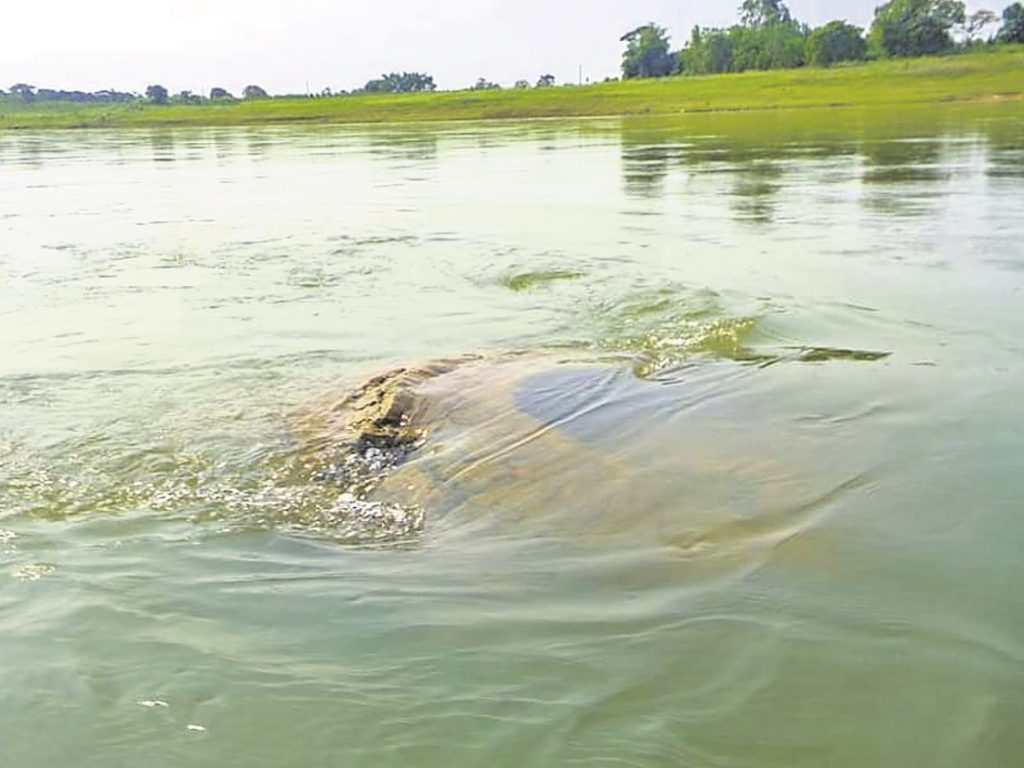Nayagarh: Ever since the emergence of the summit structure (Dadhinauti) of an ancient temple from the waters of River Mahanadi, Padmabati village under Bhapur block in Nayagarh district has been hogging all the headlines.
According to some elderly people of the village, it is Gopinath temple’s top portion which is visible now. It was last seen 11 years ago when the Mahanadi’s water level reduced significantly. Since the re-emergence of the temple top, different theories are doing the rounds. While some claim that the submerged village was then known as Hatuari, some others say ‘Barohi’ was the name of the village.
However, there is a consensus that the temple was the tallest one in the village which is why none of the temple tops but that of Gopinath temple has emerged from the waters. The villagers also say that besides Lord Gopinath, a form of Lord Vishnu, there used to be other deities like Dadhibaman, Kamanadebi, Nrusingha and Rahasbihari in the temple.
“11 years ago the temple top was visible for the first time. But then, no research was done to throw more light on it,” some observed.
Temple’s history
According to Khandapara’s ex-MLA Anubhav Patnaik, Krupasindhu Chhotray of Gunthuni village, who happens to be his relative, used to be a minister in the court of Khandapara king Natabar Singh.
Krupasindhu’s father Keshab Baibartta had no child. Keshab had wished to construct Lord Gopinath’s temple if he was blessed with a child. It was when Keshab’s son Krupasindhu became a minister in the royal court that he fulfilled his father’s wish by getting the temple constructed in Hatuari village, a revenue village then.
“I heard it from my relatives that the temple was constructed in the year 1850,” Patnaik added.
“During a flood, the river changed its course and submerged the whole village. However, the villagers had by then moved to higher regions. They had also taken out the deities from the temple with them. They set up a new village one kilometre away from the river and named it as Padmabati village. In the newly set up village, they got another temple constructed and placed the deities in it,” he said.
The chakra of the old temple has also been placed atop the new temple. Krupasindhu Chhotray started the construction of the temple and later on his son Dasarathy Chhotray helped with the construction. Yet it had been in a half-constructed state till 2018 when the construction completed,” he informed.
What the sarpanch says about the temple
Sarpanch Srikant Sahu said he has also heard a lot about the temple. Quoting his grandfather, Sahu said, “The 1933 flood in Mahanadi submerged over 20 temples including Gopinath temple. Before submergence, there used to be over 7,000 people in the village. The newly set up village has less population. The ancient temple must be recovered. Then only it can be known whether the temple has the idols or have been brought to the new temple.”
What experts say about the temple
At the same time, archeology expert Surendra Mishra was sanguine about the existence of the ancient temple. “Since the top portion of the temple still exists, it suggests that the whole structure including the foundation should be intact. It is believed that the temple was constructed during the time of Surya dynasty ruler Purusottam Dev. During Kanchi Abhiyan, the then kings of Nayagarh, Ranpur, Khandapara and Dasapalla assisted Purusottam Dev. In the years that followed, several temples were constructed under the auspices of Surya dynasty,” Mishra added.
What a 95-year-old resident says about the temple
Remembering his childhood days, a 95-year-old Devraj Sahu said his father used to take him to the temple many times. “I can still remember the moments I spent inside the temple enjoying fairs, kirtans and other activities. The temple’s architectural designs were captivating,” he added.
Local residents urged the government to take steps to recover the temple as it can throw more light on the temple architecture of that era.
PNN
